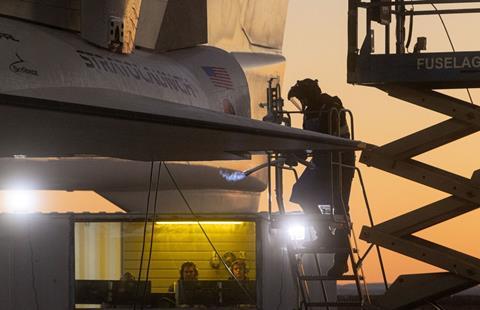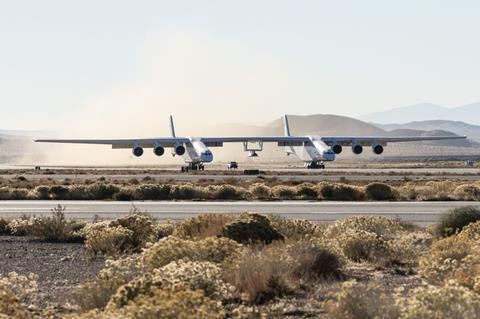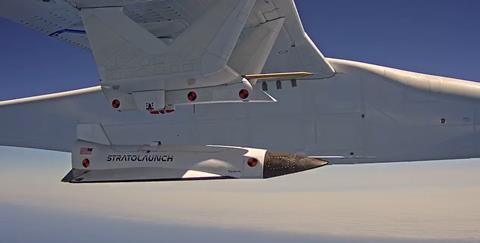US hypersonic development firm Stratolaunch has taken another step toward the first powered flight of its TalonA vehicle.
The Mojave, California-based company on 21 November completed taxi testing of its two-aircraft, “captive carry” hypersonic flight system, for the first time with the TalonA loaded with live propellant.
Stratolaunch confirmed the milestone later the same day.

“We’re moving forward on our preparation for the first powered flight of the TalonA hypersonic vehicle,” Stratolaunch says. “Today we successfully completed a taxi test, the first time with live propellants on board.”
The company hopes to achieve the first powered flight of TalonA before the end of 2023. However, a company official tells FlightGlobal that schedule will be dependent upon the results of data collected during the latest taxi test.
If that review finds no issues, Stratolaunch will attempt to reach hypersonic speed, generally defined as Mach 5, during that first TalonA flight.
Stratolaunch’s hypersonic flight system incorporates two separate elements: the heavy-lift, captive carry aircraft known as Roc and the TalonA flight vehicle, which will achieve speeds of M5 and beyond.
Roc is believed to be the largest aircraft currently flying anywhere in the world.

The twin-fuselage, all-composite over-wing design (registration N351SL) was created by Scaled Composites as a purpose-built air-launch vehicle for Stratolaunch.
Roc boasts a 117m (385ft) wingspan and is powered by six engines originally developed for the Boeing 747 commercial airframe. Stratolaunch says Roc boasts a capacity of 226,800kg (500,000lb).
The TalonA hypersonic flight vehicle is carried below Roc’s wing and in between the twin fuselages. The rocket-propelled, autonomous, testbed aircraft are powered by Hadley engines, developed by Colorado-based manufacturer Ursa Major.
Stratolaunch’s goal for the TalonA platform is to create a reusable flight vehicle capable of accelerating customisable payloads to hypersonic speeds. Aerospace manufacturers and military customers could then use the TalonA to more efficiently test developmental hypersonic systems.
The TalonA vehicle that will make the type’s first powered flight is an expendable variant designated TA-1.
As part of its progression to hypersonic flight, Stratolaunch has already completed multiple captive carry flights, with Roc hauling a TalonA test article – designated TA-0 – to 22,500ft.

The company also completed a successful separation test of the system in May, releasing TA-0 from its carry position aboard Roc while in flight.
Stratolaunch declined to share any details of the flight profile for that event, citing security concerns related to customer payloads. The US Air Force (USAF) is among the backers of the TA-1 flight programme, with the Air Force Research Laboratory providing funding to Stratolaunch in 2022.
However, a company official tells FlightGlobal the primary milestones for a successful flight will be safe separation of TA-1 from Roc, flight vehicle stabilisation, rocket motor ignition and achieving hypersonic trajectory.
If the TA-1 powered flight is successful, Stratolaunch will move on to flights of reusable TalonA vehicles.
The company has three such craft either complete or under fabrication, with the designations TA-2, TA-3 and TA-4.
The USAF in October awarded Stratolaunch funding to support the fabrication and flight of TA-3.


























